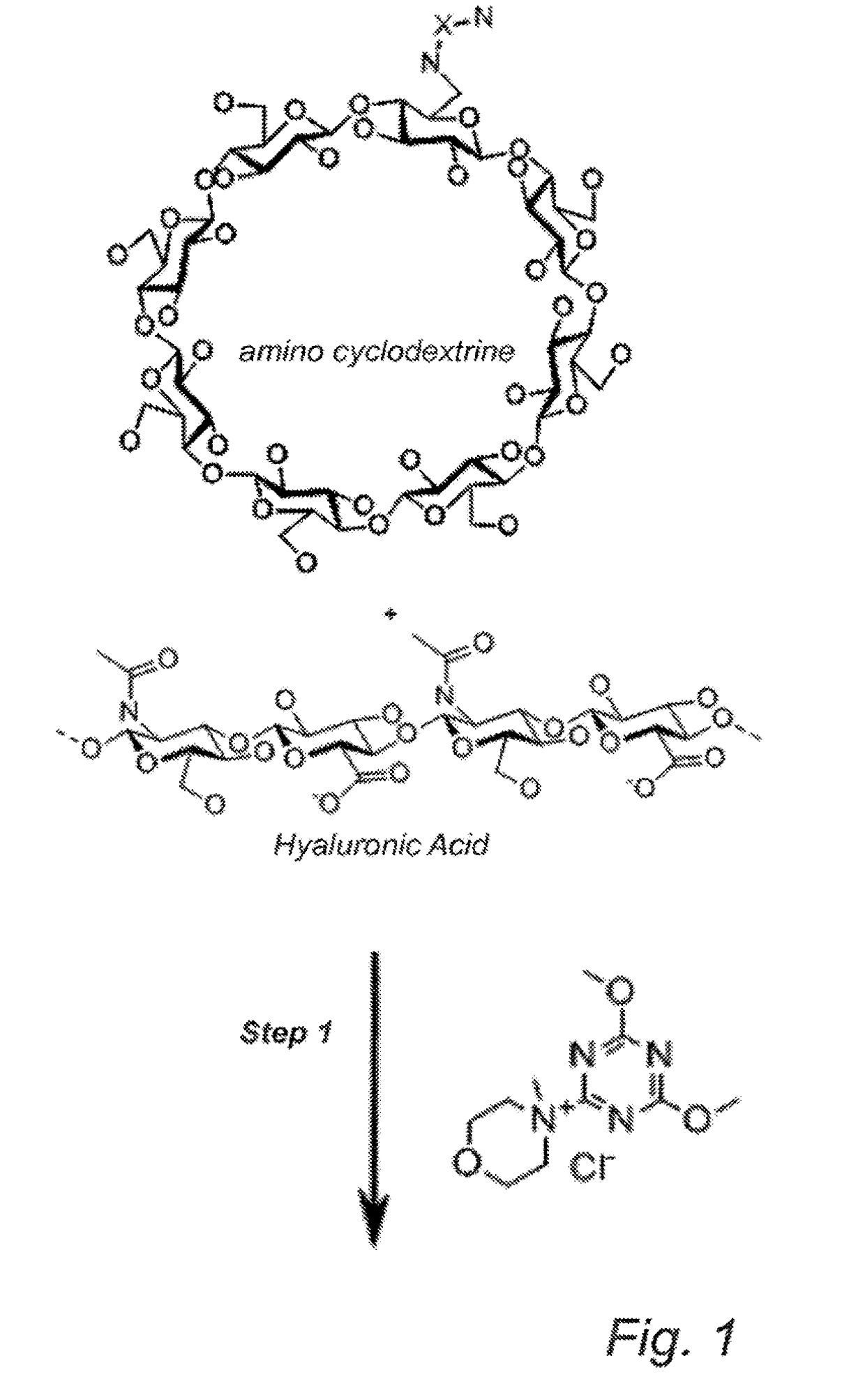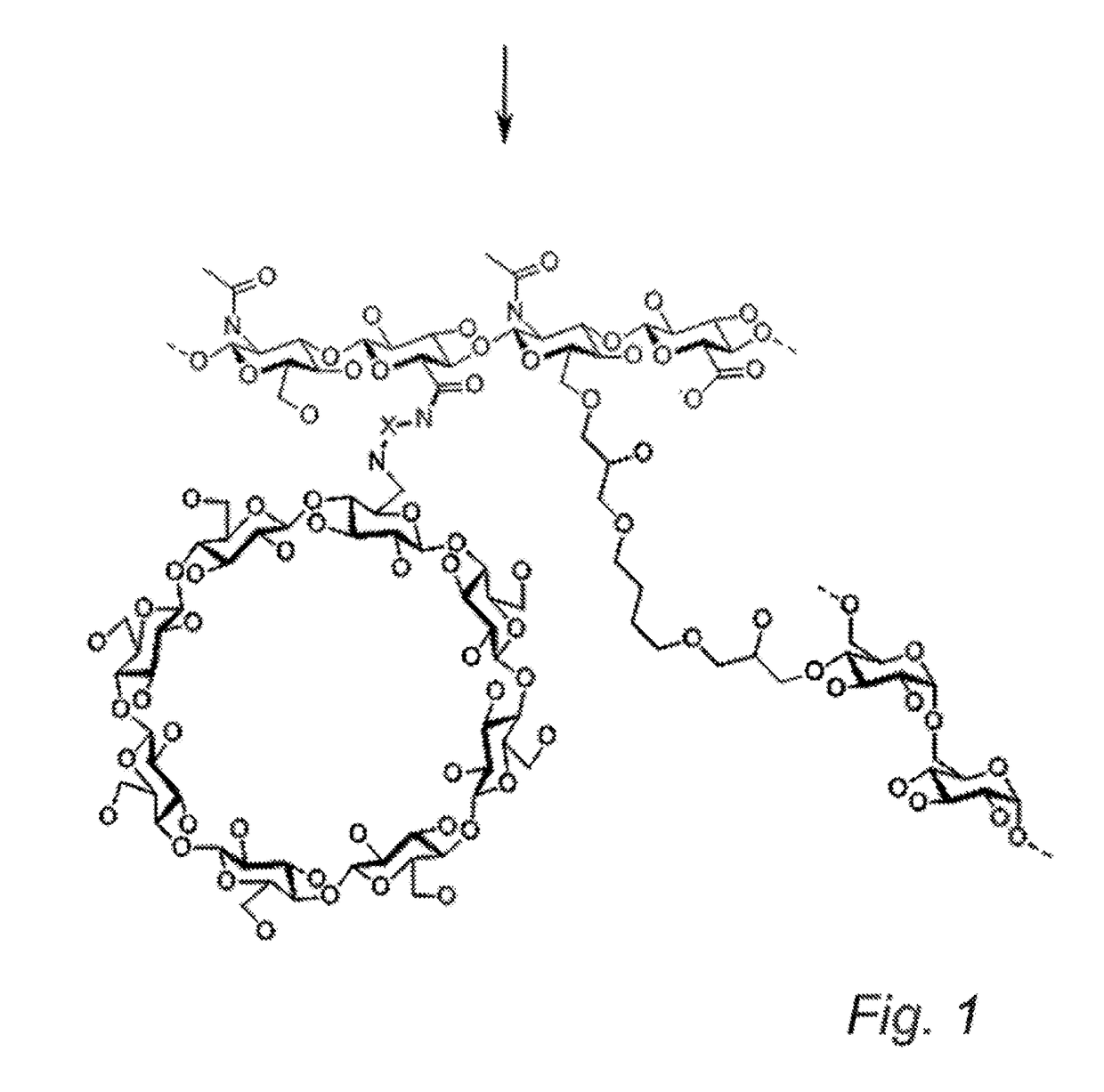Cyclodextrin-grafted hyaluronic acid crosslinked with dextran and uses thereof
a technology of hyaluronic acid and dextran, which is applied in the field of hydrogels, can solve the problems of affecting the liquid retention capacity of hyaluronic acid molecules
- Summary
- Abstract
- Description
- Claims
- Application Information
AI Technical Summary
Benefits of technology
Problems solved by technology
Method used
Image
Examples
example 1
Grafting of 6-Amino-Gamma-CD to HA, Followed by Cross-Linking to Dextran
[0114]DMTMM (0.3 g) and 6-amino-gamma-CD (0.8 g) are dissolved in phosphate-buffered saline (PBS) (25 mL), and the pH of the solution is adjusted to approx. 6.5 (1.2 M HCl). This solution is added to dry HA powder (0.3 g) and then stirred gently. The reaction is heated to 45° C. for 24 h and then allowed to cool down to room temperature. The product is washed twice with PBS (15 mL / g gel) and filtrated. The product is then washed three times with ethanol 70% (15 mL / g gel) and the solution is discarded.
[0115]Dextran powder (0.1 g) is dissolved in PBS (25 ml), and the pH of the solution is adjusted to approx. 9.0 using NaOH. This solution is added to the cyclodextrin-grafted HA and then stirred gently. Cross-linking reagent BDDE is added and allowed to react with the the polymer mixture in solution, forming a gel. The gel is washed twice with PBS (15 mL / g gel) and filtrated. The gel is then washed three times with ...
example 2
Characterization of HA-Cyclodextrin-Dextran Product
[0116]The HA-cyclodextrin-dextran gel obtained in Example 1 is characterized by the swelling, i.e. the ability to absorb water, and the viscoelastic properties. Swelling is expressed as the amount of water in gram that one gram dry cross-linked HA-dextran polymer can absorb. The viscoelastic properties are measured by rheometry, and are expressed as the storage modulus (G′) and the loss modulus (G″).[0117]The chemical composition of the HA-cyclodextrin-dextran is obtained by proton NMR spectroscopy after degradation of the HA polysaccharide strands by hylauronidase or equivalent to obtain sharp lines in the spectrum enabling proper quantification.[0118]The chemical linking between HA, dextran and cyclodextrin is characterized by size exclusion chromatography coupled to mass spectrometry after degradation by both hylauronidase and dextranase or equivalent.
example 3
Grafting of 3-Amino-Gamma-CD to HA, Followed by Cross-Linking to Dextran
Step 1: Grafting of Cyclodextrin to Hyaluronan
[0119]The 3-amino-γ-cyclodextrin was dissolved together with the activation agent DMTMM in 1 mM PBS buffer. 1 MDa Hyaluronan (HA) was dissolved in the same solution. The reaction mixture was stirred and allowed to react. The reaction was stopped by the addition of ethanol under vigorous stirring. The precipitate was isolated by decantation, washed with 70% ethanol (w / w) then with pure ethanol and dried in a vacuum oven at 23° C. over night.
[0120]The cyclodextrin conjugated hyaluronan was analysed by 1H-NMR after enzymatic degradation of the polymer with chondroitinase ABC. A modification degree (cyclodextrin per hyaluronan disaccharide, (MOD CDx / HAdi)) of 8 to 12% was obtained.
Step 2: Formation of a Hydrogel by Cross-Linking a Mixture of Modified Hyaluronan and Dextran.
[0121]Cyclodextrin-conjugated HA having a modification degree (MOD CDx / HAdi) of 12% was placed toge...
PUM
| Property | Measurement | Unit |
|---|---|---|
| size | aaaaa | aaaaa |
| molecular weights | aaaaa | aaaaa |
| concentration | aaaaa | aaaaa |
Abstract
Description
Claims
Application Information
 Login to View More
Login to View More - R&D
- Intellectual Property
- Life Sciences
- Materials
- Tech Scout
- Unparalleled Data Quality
- Higher Quality Content
- 60% Fewer Hallucinations
Browse by: Latest US Patents, China's latest patents, Technical Efficacy Thesaurus, Application Domain, Technology Topic, Popular Technical Reports.
© 2025 PatSnap. All rights reserved.Legal|Privacy policy|Modern Slavery Act Transparency Statement|Sitemap|About US| Contact US: help@patsnap.com



